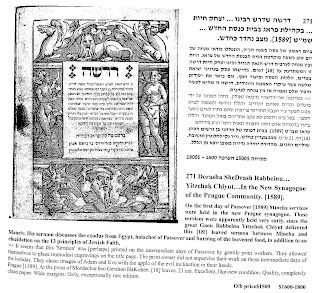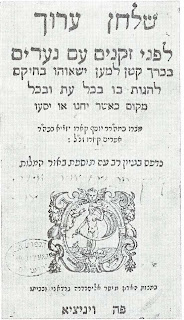A Conspiracy Theory To Explain A Racy Title Page
“that this ‘Sermon’ was [perhaps] printed on the intermediate days of Passover by gentile print workers. They allowed themselves to place immodest engravings on the title page. The print owner did not supervise their work on these intermediate days of the holiday. They chose the images of Adam and Eve with the apple of the evil inclination in their hands.”
Thus, according to the catalog editors, the appearance of these illustration is due is basically an error, or if you wish, a rather interesting conspiracy theory.
Now, obviously, it is impossible to prove the negative, that is we have no way of saying 100% the above scenario did not happen, but I think at the very least we can show it is unlikely. First, perhaps the most straightforward item is that we have seen such illustration are not an anomaly – I have provided below one such illustration that appears on the title page of the 1577 edition of the Shulchan Orach.
Second, we are aware of cases of printing that did take place on either Shabbat or Yom Tov. The eminent bibliophile, Abraham Yaari, provides a list of such books. See A. Yaari, Mehkerei Sefer, Jerusalem, 1958, pp. 170-78. The method he employees in deciding which books were published on Shabbat or Yom Tov, is not conjecture. Instead, when a book was published when Jews were unable to oversee the printing, there was a much bigger problem than the title page illustration. When non-Jews printed without the aid of Jews, as one would imagine, the book was then subject to many typographical errors as the non-Jews, for the most part, could not read or understand Hebrew. Thus, typically, there would be a disclaimer somewhere in the book stating that there maybe such errors due to lack of Jewish supervision. In the case of this book of Derashot, there is no such disclaimer.
Finally, the entire assumption is highly questionable. That is, according to some one is allowed to print books on the intermediate days of a holiday. Famously, R. Yosef Karo’s maggid explicitly tells R. Karo that he must write down what the maggid tells him even on the intermediate days. (For other illustration and a discussion of the above, in Hebrew, see here.)





One thought on “A Conspiracy Theory To Explain A Racy Title Page”
I just want to tell you that I’m newbie to blogging and absolutely liked your website. Most likely I’m want to bookmark your site . You surely have amazing posts. Regards for revealing your web site.